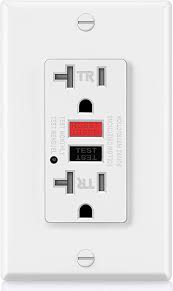What are Ground Fault Circuit Interrupter (GFCI) Outlets?
So you had a home inspection done and your inspector mentioned that the house was missing GFCI outlets or had defective ones. So what does that mean? Even though you may not be familiar with the term GFCI outlets, you are almost certainly familiar with what they look like. GFCI outlets are typically found near water sources, such as in a bathroom or in the kitchen (we will discuss exactly where they should be installed shortly) and they have two buttons on the receptacle itself, a “test” and a “reset” one. Sometimes these buttons are black and red in color. Here is a picture of what one looks like:

Why are GFCI Outlets Necessary?
GFCI outlets are constantly checking to make sure that the same amount of electrical current leaving the outlet is also coming back to it. If the outlet notices a difference in this electrical current it will trip, shutting off power to whatever is plugged into it in less than a tenth of a second. This can save one from an unpleasant and possibly even deadly shock. Here is a scenario of when a GFCI would protect you; let’s say you have your sink basin full of water as you are cleaning dishes in it. Next to the sink your toaster is getting your bagel heated for breakfast. As you reach to put a dish into the sink you accidentally knock the toaster into the sink. Anyone’s normal reaction to this would be to immediately reach into the water to get the toaster out and save your bagel. If the outlet your toaster is plugged into isn’t protected by a GFCI outlet, then the water will have become electrically charged and dangerous, although you won’t know this until you have reached into the water. Now if the toaster had been plugged into a GFCI, the outlet would have realized something wasn’t right since it was losing electrical current to the water. The GFCI would trip, turning off power to the toaster and thereby making it safe to reach in. The toaster could be safely retrieved and the reset button pressed on the GFCI outlet to get it operational again.
Where are GFCI Outlets Required?
GFCI receptacles provide a critical safety feature, especially when the outlet is located near a water source or an area where water may be present. Currently, the National Electrical Code (NEC) requires GFCI outlets to be used for any receptacles within 6′ of a water source, in bathrooms, kitchens, unfinished basements, garages, and the exterior. If a home doesn’t have GFCI’s installed in these locations it is recommended to contact an electrician to have them installed. This is typically a relatively easy repair to have done.

